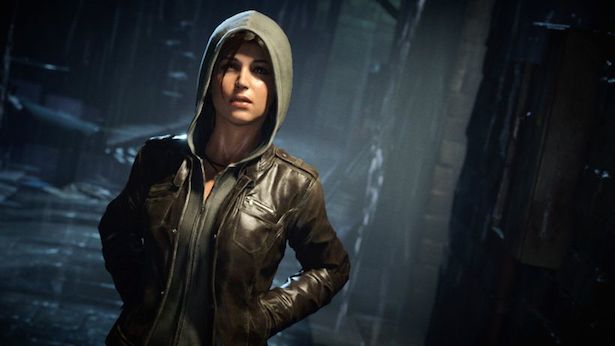I’ve written a couple posts on Rise of the Tomb Raider already because I’ve been playing the game a lot lately, and while I’ve been playing, I’ve also been watching Jessica Jones on Netflix. As a result of my concurrent engagement with both, I’ve been thinking that the two seem to converse with each other, especially considering the manner in which they both deal with traumatic pasts and depictions of troubled, conflicted female (super)heroes.
 Indeed, Jessica Jones as a character has received a lot of praise lately for the manner in which she is complicatedly rendered. Indeed, David Sims of The Atlantic celebrates Jessica Jones for its exploration of “themes of trauma, abuse, and prejudice” and for the fact that it “operates in shades of grey, offering a complex character who’s haunted by a scarily mundane supervillain, and working through tribulations in sometimes ill-advised ways.” Sims extends this line of thinking by highlighting Jessica Jones’s characterization as “a tough, pugnacious heroine who’s as aggressive in her romantic pursuits as she is on the job” and her being, at the same time, “troubled by her past experiences.” And, ultimately, Sims praises the manner in which the show “conveys Jessica’s vulnerability without ever making her seem helpless, or losing her sense of the show’s dark humor. This is a show about a survivor of rape and abuse, and although it occasionally dances around definitive language on the subject matter, its engagement with it is sensitively done and powerfully affecting.” In other words, Sims appreciates the manner in which Jessica Jones “fleshes out Jessica’s inner demons without losing sight of the fact that this is a superhero drama.”
Indeed, Jessica Jones as a character has received a lot of praise lately for the manner in which she is complicatedly rendered. Indeed, David Sims of The Atlantic celebrates Jessica Jones for its exploration of “themes of trauma, abuse, and prejudice” and for the fact that it “operates in shades of grey, offering a complex character who’s haunted by a scarily mundane supervillain, and working through tribulations in sometimes ill-advised ways.” Sims extends this line of thinking by highlighting Jessica Jones’s characterization as “a tough, pugnacious heroine who’s as aggressive in her romantic pursuits as she is on the job” and her being, at the same time, “troubled by her past experiences.” And, ultimately, Sims praises the manner in which the show “conveys Jessica’s vulnerability without ever making her seem helpless, or losing her sense of the show’s dark humor. This is a show about a survivor of rape and abuse, and although it occasionally dances around definitive language on the subject matter, its engagement with it is sensitively done and powerfully affecting.” In other words, Sims appreciates the manner in which Jessica Jones “fleshes out Jessica’s inner demons without losing sight of the fact that this is a superhero drama.”
Carolyn Petit’s review of Rise of the Tomb Raider operates off a similar line of interrogation—examining the manner in which Lara Croft’s experiences with trauma are explored in the latest two iterations of the series—but her analysis works to reveal the games’ limitations in their characterizations of their protagonist:
2013’s Tomb Raider reboot gave us a new, and at least superficially more human, Lara Croft. Gone were the cartoonish features and Barbie doll proportions of the legendary adventurer. The new Lara Croft looked like a real person. The story half-heartedly tried to make her act like one, too, showing her feel guilty about killing a deer early on, but Lara’s internal conflict was quickly swept aside as she became a walking arsenal, slaughtering enemies by the dozens with bows, pistols, shotguns and other weapons.
And as Petit points out, Rise of the Tomb Raider similarly sweeps aside the exploration of trauma that the first teaser trailer seemed to imply would be an important part of the game’s story:
The first teaser trailer for the sequel, Rise of the Tomb Raider, showed a seemingly troubled Lara in a therapist’s office, so I hoped that this game might be that rare blockbuster action adventure that at least takes violence somewhat seriously. I hoped it might acknowledge that even if you were in a situation where you absolutely had to kill hundreds of really, really bad people to survive, doing so would probably leave you a little traumatized. But Rise of the Tomb Raider doesn’t do that.
As such, Petit argues, the game’s lack of discussion of trauma results in “a remarkable dissonance between Lara’s attitudes in the story and the experience of playing the game. When she’s asked about it, Lara asserts that she did not enjoy all the killing she did in the first game, she did it because she had no choice. But she also doesn’t seem troubled about it.”
 To be sure, this dissonance, as Petit continues, occurs as a result of the game’s problematically limited engagement with Lara’s survivor status, the fact that the game wants us to “see Lara as a survivor, a person with deep, real emotions who doesn’t relish violence but does what needs to be done. But meanwhile, the game revels in violence…Playing as Lara, you don’t feel like someone desperately fighting just to survive. You feel like someone who is very, very good at killing people and doesn’t hesitate to do it.” And because the game wants us to see Lara as a conflicted survivor, because it wants us to think of her as someone who doesn’t want to—but has to—engage in violence, it, conversely, “just doesn’t want to acknowledge that Lara clearly enjoys it, and the disconnect between the narrative’s portrayal of Lara as someone who feels things deeply and doesn’t enjoy violence at all and the gameplay’s attempts to make violence as fun and explosive as possible is really jarring.” And Petit sees this problem as being a result of the game’s desire to “humanize Lara” without fully committing to doing so, since “exploring the emotional and psychological cost of what she’s putting herself through would have made her seem more human.”
To be sure, this dissonance, as Petit continues, occurs as a result of the game’s problematically limited engagement with Lara’s survivor status, the fact that the game wants us to “see Lara as a survivor, a person with deep, real emotions who doesn’t relish violence but does what needs to be done. But meanwhile, the game revels in violence…Playing as Lara, you don’t feel like someone desperately fighting just to survive. You feel like someone who is very, very good at killing people and doesn’t hesitate to do it.” And because the game wants us to see Lara as a conflicted survivor, because it wants us to think of her as someone who doesn’t want to—but has to—engage in violence, it, conversely, “just doesn’t want to acknowledge that Lara clearly enjoys it, and the disconnect between the narrative’s portrayal of Lara as someone who feels things deeply and doesn’t enjoy violence at all and the gameplay’s attempts to make violence as fun and explosive as possible is really jarring.” And Petit sees this problem as being a result of the game’s desire to “humanize Lara” without fully committing to doing so, since “exploring the emotional and psychological cost of what she’s putting herself through would have made her seem more human.”
In thinking about all this, I’m struck by the fact that Jessica Jones and Rise of the Tomb Raider—which were released within days of each other—are surrounded by similar conversations regarding their depictions of heroic female protagonists dealing with past and present violence and trauma, as evidenced in the articles by Sims and Petit that I’ve discussed here. Yet, while Sims’s analysis of Jessica Jones tends to commend the show’s efforts to explore the intersections of trauma, strength, vulnerability, and heroism (among other things) in complicated ways, Petit highlights the limitations in Rise of the Tomb Raider’s representation of conflicted morality, violence, and survival. And I tend to agree with Petit, here, because I think what it comes down to, what results in the success (or lack thereof) in these two texts’ representations of women working to be heroes in the face of trauma, is their ability (or lack thereof) to tell stories effectively. And Rise of the Tomb Raider could stand to tell Lara’s story better.




